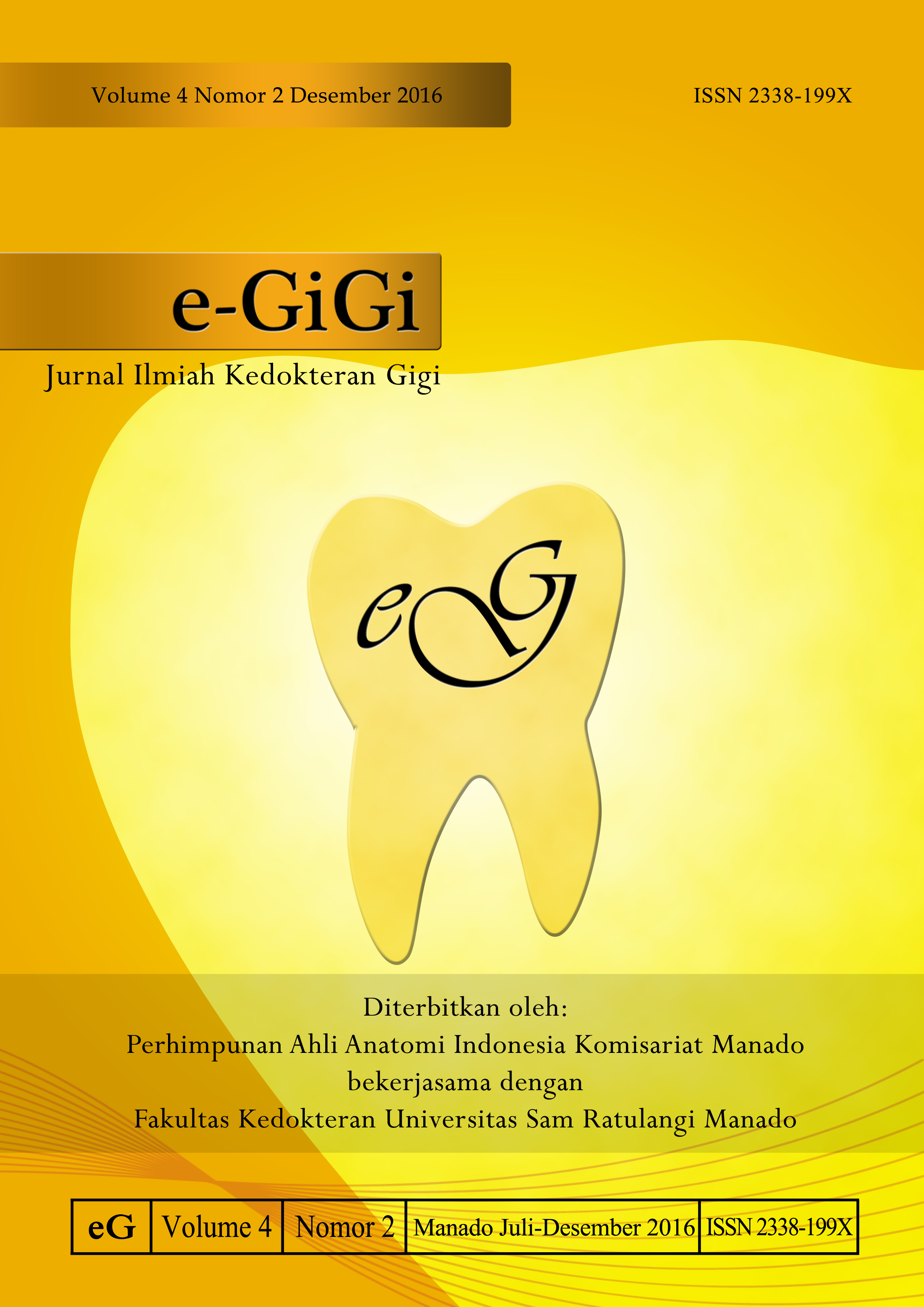Kebutuhan perawatan ortodonsi berdasarkan index of orthodontic treatment need pada siswa usia 12-13 tahun di SMP Negeri 1 Wori
DOI:
https://doi.org/10.35790/eg.4.2.2016.14164Abstract
Abstract: Malocclusion is a form of occlusal disorders caused by irregular teeth growthas well as sizes and position of teeth. Malocclusion could create some disturbances in both physical and mental health of a person including problems in oral function, mastication, highly risk of trauma, periodontal diseases, and caries. Esthetically, malocclusion could affect a person’s appearances and psychological development especially in adolescent. Orthodontic treatment is performed to fix the malocclusion that could affect one’s oral health. The needs of orthodontic treatment itself can be leveled by using Index of Orthodontic Treatment Need (IOTN). This study was aimed to obtain the needs of orthodontic treatment based on IOTN among students aged 12-13 years old at SMPN 1 Wori. This was an observational descriptive study with a cross sectional design. There were 30 respondents obtained by using purposive sampling technique. The need of treatment was leveled by using IOTN consisted of two components: aesthetic component (AC) and dental health component (DHC). The needs of orthodontic treatment measured with AC, 27 person (90%) were as follows: no need or little need for treatment in 27 students (90%); borderline need in 2 students (6.7%); and treatment required in 1 student (3.3%). The needs of orthodontic treatment based on DHC were as follows: no need or little need for treatment in 18 students (60%); borderline need in 8 students (26.7%); and treatment required in 4 students (13.3%).
Keywords: malocclusion, needs of orthodontic treatment, IOTN.
Â
Abstrak: Maloklusi merupakan penyimpangan oklusi akibat tidak teraturnya pertumbuhan, posisi, serta ukuran gigi. Maloklusi dapat menyebabkan gangguan kesehatan fisik dan psikis, antara lain dapat mengganggu fungsi oral, mastikasi, berisiko tinggi terhadap trauma, penyakit periodontal, dan karies. Maloklusi secara estetis juga dapat memengaruhi penampilan wajah seseorang dan perkembangan psikologis terutama pada remaja. Perawatan ortodonsi ditujukan untuk memperbaiki maloklusi yang dapat memengaruhi kesehatan gigi dan rongga mulut. Perawatan ortodonsi yang tepat dapat dilihat dari tingkat kebutuhan perawatan ortodonsi yang diukur dengan Index of Orthodontic Treatment Need (IOTN). Penelitian ini bertujuan untuk mengetahui kebutuhan perawatan ortodonsi berdasarkan IOTN pada siswa berusia 12 - 13 tahun di SMP N 1 Wori. Jenis penelitian ialah deskriptif observasional dengan desain potong lintang. Subjek penelitian berjumlah 30 siswa diperoleh dengan teknik purposive sampling. Kebutuhan perawatan ortodonsi menggunakan Index of Orthodontic Treatment Need (IOTN) dengan dua komponen, yaitu Aesthetic Component (AC) dan Dental Health Component (DHC). Kebutuhan perawatan ortodonsi berdasarkan AC yaitu: 27 orang (90%) tidak atau butuh perawatan ringan; 2 orang (6,7%) perawatan borderline; dan 1 orang (3,3%) sangat butuh perawatan. Kebutuhan perawatan ortodonsi berdasarkan DHC yaitu: 18 orang (60%) tidak atau butuh perawatan ringan; 8 orang (26,7%) perawatan borderline, dan 4 orang (13,3%) sangat butuh perawatan.
Kata kunci: maloklusi, kebutuhan perawatan, IOTN
Downloads
Published
How to Cite
Issue
Section
License
COPYRIGHT
Authors who publish with this journal agree to the following terms:
Authors hold their copyright and grant this journal the privilege of first publication, with the work simultaneously licensed under a Creative Commons Attribution License that permits others to impart the work with an acknowledgment of the work's origin and initial publication by this journal.
Authors can enter into separate or additional contractual arrangements for the non-exclusive distribution of the journal's published version of the work (for example, post it to an institutional repository or publish it in a book), with an acknowledgment of its underlying publication in this journal.
Authors are permitted and encouraged to post their work online (for example, in institutional repositories or on their website) as it can lead to productive exchanges, as well as earlier and greater citation of the published work (See The Effect of Open Access).






